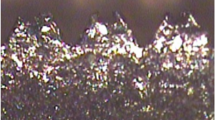Abstract
The small blind internal thread (SBIT) plays a very important role to firmly fastening some functional components on the cover of 3C electronic products. The small internal thread was made in a blind hole using a fluteless forming tap (FFT) without producing chips. However, the four geometric parameters of the FFT (tool width (W), tooth root diameter (D2), front-end diameter (Df), and tooth angle (θ)) will affect the thread filling rate (f) and minimum torque (T) in tapping process. This study reports the Box-Behnken design (BBD), combined with DEFORM-3D (finite element model) and MINITAB (regression analysis) software, to tap 7075-T6 aluminum alloy with small FFT to obtain reliable results of thread filling rate and minimum torque. The experimental results show that the BBD can accurately predict and simulate the thread filling rate of tapping 7075-T6 aluminum alloy. The modeling software and experimental design used in this research are very suitable for the optimal design of the FFT used in industrial production.
















Similar content being viewed by others
Data availability
All necessary data are shown in the figures and tables within the document. The raw data can be made available upon request.
References
Chowdhary S, Ozdoganlar OB, Kapoor S, DeVor R (2002) Modeling and analysis of internal thread forming. Trans NAMRC/SME 30:329–336
Warrington C, Kapoor SG, DeVor RE (2005) Experimental investigation of thread formation in form tapping. J Manuf Sci Eng 127:829–836
Fromentin G, Poulachon G, Moisan A, Julien B, Giessler J (2005) Precision and surface integrity of threads obtained by form tapping. CIRP Ann- Manuf Technol 54:519–522
Demmerling AL, Söffker D (2020) Improved examination and test procedure of tapping torque tests according to ASTM D5619 using coated forming taps and water-mixed metalworking fluids. Tribol Int 145:106151
Fromentin G, Poulachon G, Moisan A (2006) An experimental and analytical method for investigating plastic flow in form tapping. Int J Forming Process 9:457–472
Pereira IC, Faria AE, Da Silva MB (2013) Influence of feed rate and threaded length in thread forming and tapping operations. Proc World Congr Eng (WCE 2013) 3, London, U.K
Oliveira J, Filho S, Brandão L (2019) Investigation of the influence of coating and the tapered entry in the internal forming tapping process. Int J Adv Manuf Technol 101:1051–1063
Warrington C, Kapoor SG, DeVor RE (2006) Finite element modeling for tap design improvement in form tapping. J Manuf Sci Eng 128:65–73
Mathurin F, Guillot J, Stéphan P, Daidié A (2009) 3D finite element modeling of an assembly process with thread forming screw. J Manuf Sci Eng 131:151–158
Stéphan P, Mathurin F, Guillot J (2011) Analytical study of maximal tapping torque during forming screw process. J Mater Process Technol 211:212–221
Huang XL, Li XF, Zuo DW, Miu H, Shi DB (2012) Effect of structural parameters of extrusion tap on torque during forming process of internal thread by cold extrusion. Tool Eng 10:18–22
Carvalho AO, Brandão LC, Panzera TH, Lauro CH (2012) Analysis of form threads using fluteless taps in cast magnesium alloy (AM60). J Mater Process Technol 212:1753–1760
Filho S, Oliveira J, Arruda E, Brandão L (2016) Analysis of burr formation in form tapping in 7075 aluminum alloy. Int J Adv Manuf Technol 84:957–967
Tsao CC, Kuo KL (2012) Ultrasonic-assisted vibration tapping using taps with different coating. Trans Nonferrous Met Soc China 22:764–768
Pereira IC, Vianello PI, Boing D, Guimarães G, Da Silva MB (2020) An approach to torque and temperature thread by thread on tapping. Int J Adv Manuf Technol 106:4891–4901
Swissi A, Soussi H, Abid M, Krichen A (2019) Internal and interface shear behaviors of cut and form tapping thread. Int J Adv Manuf Technol 105:3463–3475
Ren J, Yan XG (2021) Tapping simulation to reduce radial pitch diameter difference of threads. Int J Adv Manuf Technol. https://doi.org/10.1007/s00170-021-08458-5
Brandão G, Do Carmo Silva P, De Freitas S, Pereira R, Lauro C, Brandão L (2020) State of the art on internal thread manufacturing: a review. Int J Adv Manuf Technol 110:3445–3465
Chen ZZ, Li ZL, Niu JB, Zhu LM (2020) Chatter detection in milling processes using frequency-domain Rényi entropy. Int J Adv Manuf Technol 106:877–890
Acknowledgements
The authors gratefully acknowledge the support of the Ministry of Science and Technology of the Republic of China, through Grant nos. MOST 108-2221-E-262-002-MY2.
Funding
The authors appreciate the financial support of the Ministry of Science and Technology of the Republic of China (MOST 108–2221-E-262–002-MY2).
Author information
Authors and Affiliations
Contributions
M-CW: Conceptualization, guided experimental process, data curation, characterization, validation, analysis, supervision, and writing—review and editing draft. W-RJ: Conducted the simulation, methodology, tapping experiments, and writing-original draft. L-SH: Conducted the manufacture of forming tap. C-CT: Conceptualization, project administration, funding acquisition, and revised some grammar. All authors have read and agreed to the published version of the manuscript.
Corresponding authors
Ethics declarations
Ethics approval
Not applicable.
Consent to participate
Not applicable.
Consent to publish
Not applicable.
Conflict of interest
The authors declare no competing interests.
Additional information
Publisher's Note
Springer Nature remains neutral with regard to jurisdictional claims in published maps and institutional affiliations.
Rights and permissions
About this article
Cite this article
Wu, MC., Jian, WR., Hsu, LS. et al. Optimization of tool geometric parameters for a small fluteless forming tap (FFT). Int J Adv Manuf Technol 120, 3437–3449 (2022). https://doi.org/10.1007/s00170-022-08955-1
Received:
Accepted:
Published:
Issue Date:
DOI: https://doi.org/10.1007/s00170-022-08955-1



